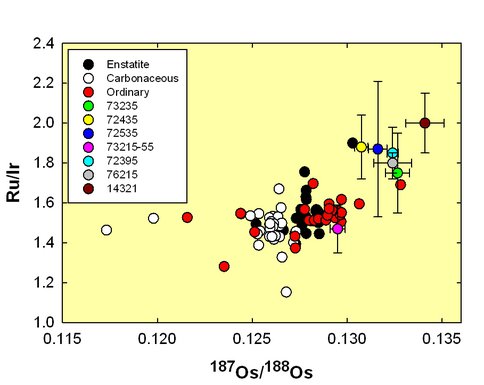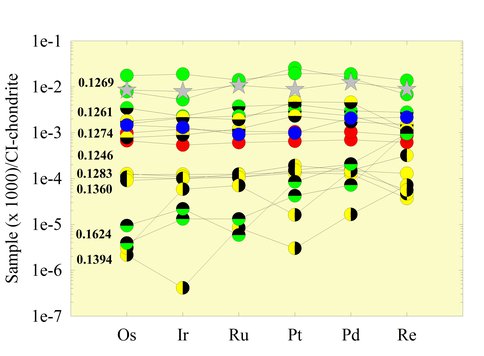2011 Annual Science Report
 NASA Goddard Space Flight Center
Reporting | SEP 2010 – AUG 2011
NASA Goddard Space Flight Center
Reporting | SEP 2010 – AUG 2011
Fingerprinting Late Additions to the Earth and Moon via the Study of Highly Siderophile Elements in Lunar Impact Melt Rocks
Project Summary
Three new lunar Apollo 17 impact melt breccias have been examined for highly siderophile element (HSE) abundances and Os isotopic compositions. A now considerable database for impact melt rocks from this site is consistent with a uniform signature imparted to rocks from this site by a single major impactor, most likely the Serenitatis impactor. The composition of this impactor was broadly chondritic, but characteristically enriched in Re, Ru and Pd relative to most chondrites. Dynamical calculations and HSE measurements on diogenites suggest that stochastic late accretion can be extrapolated to relatively small bodies, the size of Vesta.
Project Progress
In the past year, GCA Co-Investigator Walker and colleagues at the University of Maryland (Dept. of Geology) have focused on three major goals.
1. Continued analysis of Apollo 17 impact melt rocks.
We have continued analysis of Apollo 17 lunar impact melt rocks for highly siderophile elements (HSE: Re, Os, Ir, Ru, Pt, and Pd). This work comprises a major part of Miriam Galenas’ Ph.D. project. The overarching purpose of this work is to fingerprint the HSE characteristics of late heavy bombardment (~4.0 to 3.8 Ga) additions to the Moon (and presumably the Earth) using the relative abundances of highly-siderophile elements (HSE) that occur in generally high abundance in likely lunar impactors, but in extremely low abundance in the indigenous lunar crust. In addition to characterizing the HSE signature of the impactor(s), a major objective of this work is to document the level of impactor homogeneity/heterogeneity present at the Apollo 17 site. Although prior studies have argued the chemical signature observed in Apollo 17 impact melt rocks was derived from the Serenitatis event, some recent studies have suggested the possibility for an Imbrium component as well. Our latest data for new poikilitic samples plot with very similar relative abundances of HSE to the previously published data for poikilitic melt rocks. As previously noted, the impactor source that dominates the HSE signature of these rocks has generally higher 187Os/188Os (long-term Re/Os), Ru/Ir and Pd/Ir ratios than bulk chondrites. Of note, in contrast with the earlier results for aphanitic samples 73215 and 73255, a newly analyzed aphanitic rock, 73235, plots among the poikilitic samples with respect to HSE and Os isotopic characteristics.
Taking all of our HSE data into consideration (e.g., Fig. 1), poikilitic samples at the Apollo 17 site are quite similar and continue to suggest a source with 187Os/188Os, Ru/Ir, and Pd/Ir somewhat higher than the range of bulk chondrites. The HSE data for aphanite 73235 are similar to the data for the poikilitic rocks, in contrast to previous results for aphanites 73215 and 73255. This result may support some prior suggestions that the HSE in 73215 and 73255 are dominated by the HSE-rich granulitic-breccia clasts they contain, rather than by the HSE derived from the impactor in the melt fraction. The similarities of HSE characteristics in many of these melt breccias are consistent with the interpretation that most melt rocks at the Apollo 17 site are dominated by a single, Serenitatis impactor signature. Our latest results were most recently reported at the 2011 Lunar and Planetary Science Conference. We plan to complete analysis of the remaining Apollo 17 impact melt rock suite we have in the coming year, and Galenas is currently working on her first paper that will report the new results.
Figure 1. 187Os/188Os vs. Ru/Ir for lunar impact melt rocks. Error bars show regression uncertainties. For comparison, bulk chondrite data are also plotted.
2. Dynamical Modeling of Late Accretion.
We have continued a collaborative dynamical modeling project with Bill Bottke (Southwest Research Institute) that seeks to consider ways in which the very disparate apparent mass contributions of late accretion to Earth, Mars and the Moon could be accounted for. This work is also supported by a NASA NLSI grant to the Lunar and Planetary Institute. In the initial phase of this collaboration, we concluded that the Earth/Moon and Earth/Mars mass accretionary ratios of ~1200 and ~8, respectively, as recorded by HSE in the mantle of these planetary bodies, can only be explained by a process we termed “stochastic late accretion”. Stochastic late accretion is envisioned as a process whereby a very limited number of large impactors (2000-3000 km diameter) may provide matter to the Earth and Mars. Smaller, yet still large bodies may have also provided mass to the Moon prior to formation of its permanent crust. This work was published in December 2010 in Science (Bottke et al., 2010).
An important question is how to apply these ideas to the interpretation of the HSE signatures of differentiated asteroids like Vesta, which may also have been affected by late accretion. The early bombardment history of these small worlds was likely different from that of Earth, Moon, or Mars. Issues to consider include: (i) Vesta and its brethren are smaller targets than Earth/Moon/Mars, such that the largest early impactors to strike them may have been D < 100 km; (ii) if the inner main asteroid belt is any guide, the planetesimal size distribution in the inner solar system was steep for 100 < D < 250 km projectiles and shallow for D < 100 km; (iii) Vesta and other differentiated objects formed magma oceans within the first few Ma of solar system history through radioactive decay, much earlier than Mars and the Moon that formed magma oceans through late giant impacts; (iv) The starting location of these worlds is unknown; For example, Vesta might have formed in the terrestrial planet region, where it was subject to a different impactor flux. In order to expand the number and size range of bodies we can model for this process, we have begun analysis of diogenite meteorites (Fig. 2). These meteorites may represent mantle and deep crustal materials from the asteroid Vesta.
Figure 2. Highly siderophile element abundances for orthopyroxenitic and harzburgitic diogenites, normalized to CI chondrites. Also included are 187Os/188Os ratios for each sample. Pattern delineated by gray stars is Earth’s primitive upper mantle for comparison.
Chronologic evidence for eucrites and diogenites suggest early formation of Vesta and rapid differentiation and crystallization. Thus, post-differentiation accretion to Vesta would have begun earlier than to Mars, and much earlier compared to Earth and the Moon. Although some diogenite samples are brecciated and possibly contain late-stage chondritic contaminants, many of the samples show no signs of such contamination and probably reflect bona fide HSE abundances for the mantle of the parent body. This interpretation is consistent with the general homogeneity of HSE within individual meteorites. If it is assumed that the HSE characteristics of most diogenites are reflections of processes internal to Vesta, then their generally chondritic natures, most notably reflected in chondritic 187Os/188Os, suggests chondritic additions following core formation, but prior to completion of mantle crystallization.
Models of melting planetesimals through radioactive decay indicates that only planetesimals reaching tens of km in radius before 1.5 Ma after solar system formation are able to melt internally and fully differentiate. Recent modeling further indicates that significant later additions are likely to these bodies, including material that is incompletely mixed into the differentiated silicate body, and which retains its original chondritic signature. Planetesimals like Vesta, therefore, may be expected to retain compositional heterogeneity that records their magnitude and frequency of late accretion. Preliminary results of this work were reported at the 2011 Lunar and Planetary Science Conference. A manuscript detailing the work on diogenites is nearing submission.
3. Development of new tools for fingerprinting late accreted materials.
An important discovery relating to isotopic heterogeneity of the solar nebula is currently in press in the journal Geochimica et Cosmochemica Acta (Burkhardt et al., in press). In this paper, the authors report large isotopic variations in the moderately siderophile element molybdenum, among different types of meteorites, including among chondrite groups. These variations presumably result from the formation of parent bodies composed of varying mixtures of diverse nucleosynthetic components. The isotopic variations among the different types of chondritic meteorites are larger than have been identified for other elements. Molybdenum, therefore, may become a key isotopic tracer for late accreted materials. In lunar impact melt rocks, the mass balance between indigenous lunar Mo and impactor Mo, while not as favorable as highly siderophile elements, should be sufficient to permit isotopic characterization of Mo in impactor materials.
We have been analyzing Mo isotopes for mass dependent fractionations for several years, and have now begun development of techniques that allow application of the ultra-high precision capabilities of negative thermal ionization mass spectrometry to this problem This work is being spearheaded by Ph.D. student Emily Worsham. Results generated during 2011 look promising and we expect to make our first measurements on lunar rocks in 2012.
Publications
-
Bottke, W. F., Walker, R. J., Day, J. M. D., Nesvorny, D., & Elkins-Tanton, L. (2010). Stochastic Late Accretion to Earth, the Moon, and Mars. Science, 330(6010), 1527–1530. doi:10.1126/science.1196874
-
PROJECT INVESTIGATORS:
-
PROJECT MEMBERS:
Igor Puchtel
Co-Investigator
-
RELATED OBJECTIVES:
Objective 1.1
Formation and evolution of habitable planets.


